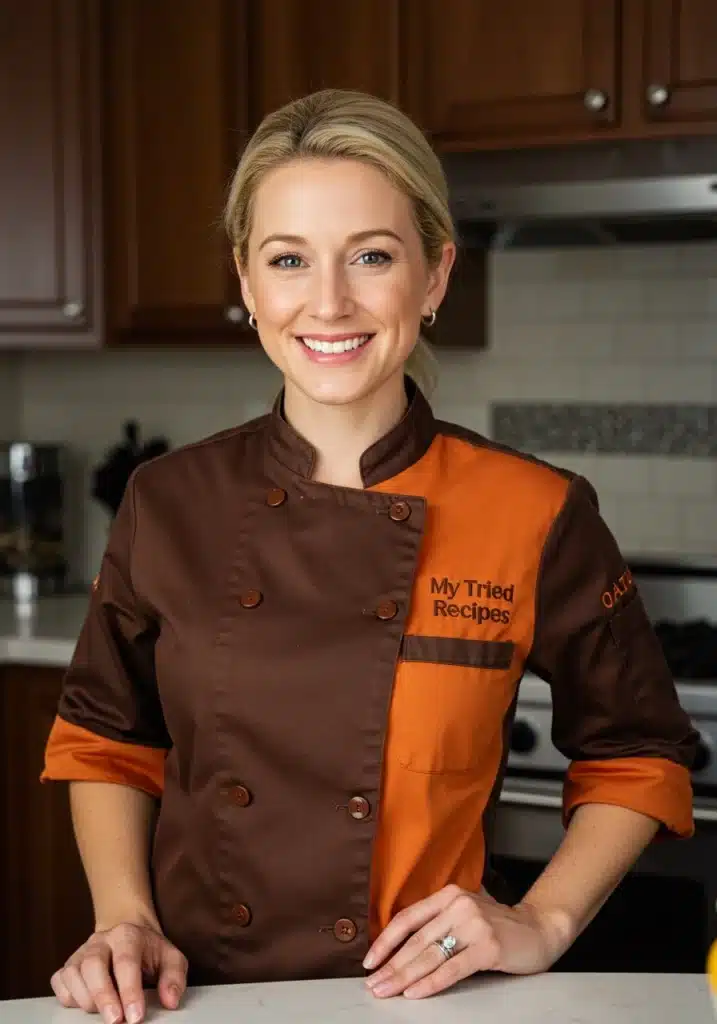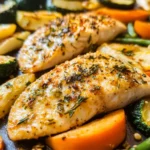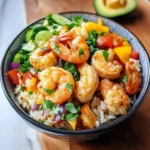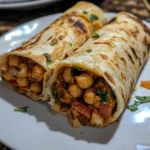This Shrimp Cauliflower Rice Bowl has become an absolute lifesaver in our household, a true culinary hero on busy weeknights when time is short but the desire for something delicious and healthy is high. I remember the first time I made it; I was skeptical about whether the cauliflower rice would truly satisfy that craving for a hearty grain. But oh, was I pleasantly surprised! The shrimp, succulent and perfectly seasoned, paired with the vibrant, crisp-tender vegetables and the surprisingly satisfying texture of the cauliflower rice, all brought together by a savory, slightly zesty sauce – it was a revelation. My partner, who usually eyes “healthy swaps” with suspicion, devoured his bowl and immediately asked when we could have it again. Even the kids, notorious for their vegetable aversion, picked out their favorite veggies and enjoyed the flavorful shrimp. It’s now a firm family favorite, celebrated for its incredible taste, its nutritional powerhouse status, and the sheer speed with which it comes together. It’s the kind of meal that makes you feel good from the inside out, proving that healthy eating can be incredibly exciting and utterly delicious.
Ingredients
- For the Shrimp & Marinade:
- 1 pound large shrimp: Peeled and deveined (about 21-25 count). The star protein, quick-cooking and delicious.
- 1 tablespoon soy sauce (or tamari for gluten-free): Adds a savory, umami depth.
- 1 teaspoon sesame oil: For a nutty, aromatic flavor.
- 1 teaspoon cornstarch (or arrowroot for paleo/Whole30): Helps create a light coating and tenderizes the shrimp.
- ½ teaspoon grated fresh ginger: Adds a warm, zesty kick.
- 1 clove garlic, minced: Essential aromatic for flavor.
- For the Cauliflower Rice & Veggies:
- 1 large head of cauliflower (about 4-5 cups riced): Or 1 (16-ounce) bag of pre-riced cauliflower. The low-carb, nutrient-dense base.
- 1 tablespoon olive oil or avocado oil: For sautéing the vegetables.
- 1 medium red bell pepper: Cored, seeded, and thinly sliced. Adds sweetness and color.
- 1 medium yellow or orange bell pepper: Cored, seeded, and thinly sliced. For more color and mild sweetness.
- 1 cup broccoli florets: Cut into small, bite-sized pieces. Adds a cruciferous crunch.
- ½ cup shredded carrots: For sweetness, color, and texture.
- 2 green onions, thinly sliced: White and green parts separated. Adds a mild oniony freshness.
- For the Sauce:
- ¼ cup low-sodium soy sauce (or tamari for gluten-free): The savory base of the sauce.
- 2 tablespoons rice vinegar: Adds a tangy brightness.
- 1 tablespoon honey or maple syrup (optional, for a touch of sweetness): Balances the savory and tangy notes. Omit for strict keto/Whole30 if not using compliant sweetener.
- 1 tablespoon sesame oil: Reinforces the nutty aroma.
- 1-2 teaspoons sriracha or chili garlic sauce (optional): Adjust to your preferred spice level.
- 1 teaspoon grated fresh ginger: More zesty warmth.
- 1 clove garlic, minced: Boosts the aromatic profile.
- For Garnish (Optional):
- Toasted sesame seeds: For a nutty crunch and visual appeal.
- Extra sliced green onions: For fresh flavor.
- Fresh cilantro leaves: Adds a bright, herbaceous note.
Instructions
- Prepare the Shrimp: In a medium bowl, combine the peeled and deveined shrimp with 1 tablespoon soy sauce (or tamari), 1 teaspoon sesame oil, cornstarch, ½ teaspoon grated ginger, and 1 minced garlic clove. Toss well to coat and set aside to marinate for at least 10-15 minutes while you prepare the other ingredients. This brief marination period infuses the shrimp with flavor and helps them cook beautifully.
- Rice the Cauliflower (if not using pre-riced): Cut the cauliflower head into florets. Working in batches, pulse the florets in a food processor until they resemble coarse grains of rice. Be careful not to over-process, or you’ll end up with cauliflower mush. Alternatively, you can use the coarse side of a box grater. Set aside.
- Prepare the Sauce: In a small bowl, whisk together all the sauce ingredients: ¼ cup soy sauce (or tamari), rice vinegar, honey/maple syrup (if using), 1 tablespoon sesame oil, sriracha (if using), 1 teaspoon grated ginger, and 1 minced garlic clove. Taste and adjust seasoning if needed. Set aside.
- Cook the Vegetables: Heat the olive oil or avocado oil in a large skillet or wok over medium-high heat. Once the oil is shimmering, add the sliced bell peppers, broccoli florets, and shredded carrots. Stir-fry for 4-6 minutes, or until the vegetables are crisp-tender. You want them to retain some bite. Add the white parts of the sliced green onions during the last minute of cooking.
- Cook the Cauliflower Rice: Push the cooked vegetables to one side of the skillet. Add the riced cauliflower to the empty side. Stir-fry the cauliflower rice for 3-5 minutes, or until it’s heated through and slightly tender. It will absorb some of the flavors from the pan. Once cooked, gently mix the cauliflower rice with the sautéed vegetables.
- Cook the Shrimp: If your skillet is large enough, push the vegetable and cauliflower rice mixture to the sides to create a space in the center. If not, remove the veggie-cauli rice mixture to a plate and set aside. Add a touch more oil to the skillet if needed. Add the marinated shrimp in a single layer to the hot center of the skillet (or the empty skillet). Cook for 2-3 minutes per side, or until pink, opaque, and cooked through. Be careful not to overcrowd the pan; cook in batches if necessary to ensure a good sear rather than steaming.
- Combine and Sauce: Return the vegetable and cauliflower rice mixture to the skillet with the cooked shrimp (if you removed it). Pour the prepared sauce over everything. Toss gently to combine and coat all ingredients evenly. Cook for another 1-2 minutes, allowing the sauce to thicken slightly and meld with the other components.
- Serve: Divide the Shrimp Cauliflower Rice Bowl mixture among serving bowls. Garnish with toasted sesame seeds, the green parts of the sliced green onions, and fresh cilantro leaves, if desired. Serve immediately and enjoy this vibrant, flavorful meal.
Nutrition Facts
- Servings: 4
- Calories per serving: Approximately 350-400 calories (This can vary based on shrimp size, oil used, and optional sweetener).
- Protein: High in protein, primarily from the shrimp, crucial for muscle repair and satiety.
- Low Carbohydrate: Significantly lower in carbs than traditional rice bowls, making it suitable for low-carb and keto-ish lifestyles.
- Rich in Fiber: The cauliflower and vegetables provide a good dose of dietary fiber, aiding digestion and promoting fullness.
- Vitamins and Minerals: Packed with vitamins like Vitamin C (from bell peppers and broccoli) and various minerals.
- Healthy Fats: Contains healthy fats from sesame oil and avocado/olive oil, beneficial for overall health.
Preparation Time
- Total Preparation and Cooking Time: Approximately 30-40 minutes.
- Prep Time: About 15-20 minutes (chopping vegetables, ricing cauliflower if not pre-riced, marinating shrimp). This can be reduced if using pre-cut veggies or pre-riced cauliflower.
- Cook Time: About 15-20 minutes (sautéing vegetables, cooking cauliflower rice, and cooking shrimp). This dish comes together quickly once the ingredients are prepped, making it ideal for a swift and satisfying meal.
How to Serve
This Shrimp Cauliflower Rice Bowl is a complete meal in itself, but here are some ways to serve and enhance it:
- As a Standalone Bowl:
- Serve hot, directly from the skillet, into individual bowls. This is the simplest and most common way to enjoy it.
- Garnish Generously:
- Toasted Sesame Seeds: Adds a delightful nutty crunch and visual appeal.
- Freshly Sliced Green Onions (green parts): Provides a pop of fresh, mild onion flavor and color.
- Chopped Fresh Cilantro or Parsley: Brightens the dish with herbaceous notes.
- A Wedge of Lime: A squeeze of fresh lime juice right before eating can elevate all the flavors.
- Extra Sriracha or Chili Flakes: For those who like an extra kick of spice.
- With a Side of Pickled Ginger:
- The tanginess of pickled ginger (like the kind served with sushi) can be a lovely complement to the savory flavors.
- As Part of a Larger Spread (for gatherings):
- If serving a crowd, you can offer it alongside other Asian-inspired dishes like spring rolls, edamame, or a light miso soup.
- Consider a Drizzle of Extra Sauce:
- If you love a saucier bowl, you can make a little extra sauce to drizzle over the top just before serving.
- For Meal Prep:
- Portion into individual containers for easy grab-and-go lunches throughout the week. It reheats well.
Additional Tips
- Don’t Overcrowd the Pan: When cooking the shrimp, ensure they are in a single layer and not too crowded. This allows them to sear properly rather than steam, resulting in a much better texture and flavor. Cook in batches if necessary.
- Customize Your Veggies: Feel free to swap or add vegetables based on what you have on hand or prefer. Snap peas, mushrooms, bok choy, edamame, or even zucchini would work wonderfully.
- Control the Spice Level: The sriracha or chili garlic sauce is optional. Adjust the amount to your liking, or omit it entirely if you prefer a milder dish. You can also offer hot sauce on the side.
- Make Cauliflower Rice Ahead: To save time, you can rice your cauliflower a day or two in advance and store it in an airtight container in the refrigerator. Many grocery stores also sell pre-riced cauliflower in the produce or frozen sections.
- Pat Shrimp Dry: Before marinating, pat the shrimp thoroughly dry with paper towels. This helps the marinade adhere better and promotes a better sear when cooking.
- Frozen Shrimp Works Well: If using frozen shrimp, make sure they are completely thawed before use. Thaw them overnight in the refrigerator or under cold running water for a quicker option. Pat dry as you would with fresh shrimp.
- Sauce Consistency: If you prefer a thicker sauce, you can add a small slurry of cornstarch (or arrowroot) and water (about ½ teaspoon cornstarch mixed with 1 teaspoon cold water) to the sauce during the last minute of cooking, stirring until it thickens.
- Storage and Reheating: Store leftovers in an airtight container in the refrigerator for up to 3 days. Reheat gently in a skillet over medium heat or in the microwave until warmed through. Avoid overcooking the shrimp during reheating.
FAQ Section
- Q: Can I make this recipe keto or paleo?
A: Yes! To make it keto, ensure your soy sauce is low-carb or use coconut aminos. Omit the honey/maple syrup or use a keto-friendly sweetener if desired. For paleo, use tamari or coconut aminos instead of soy sauce, arrowroot starch instead of cornstarch, and omit the honey/maple syrup or use a small amount of date paste or compliant sweetener. Ensure all other ingredients are paleo-compliant. - Q: My cauliflower rice often turns out mushy. Any tips?
A: The key is not to over-process it in the food processor – pulse until it resembles rice grains. Also, don’t overcook it in the skillet. Sauté it for just 3-5 minutes until it’s tender-crisp. Adding it towards the end of the vegetable cooking time helps prevent it from getting soggy from excess moisture. - Q: Can I use a different protein instead of shrimp?
A: Absolutely! This recipe is very versatile. Diced chicken breast or thighs, lean pork tenderloin strips, or even firm tofu or tempeh would work well. Adjust cooking times accordingly for the protein you choose. - Q: How do I prevent the shrimp from becoming tough or rubbery?
A: The main culprit for tough shrimp is overcooking. Shrimp cook very quickly, usually 2-3 minutes per side. They are done when they turn pink and opaque. Remove them from the heat as soon as they are cooked through. Marinating with a bit of cornstarch also helps keep them tender. - Q: Is this dish suitable for meal prepping?
A: Yes, it’s excellent for meal prep. Cook the dish as directed, allow it to cool, and then portion it into individual airtight containers. It will keep well in the refrigerator for up to 3 days. Reheat gently to maintain the texture of the shrimp. - Q: Can I use frozen vegetables for this recipe?
A: You can, but fresh vegetables will yield the best texture (crisp-tender). If using frozen vegetables (like a stir-fry mix), there’s no need to thaw them completely; add them directly to the hot skillet. They might release more water, so you may need to cook them a bit longer to allow the excess moisture to evaporate. - Q: What if I don’t have fresh ginger or garlic?
A: Fresh ginger and garlic offer the best flavor. However, in a pinch, you can substitute with ground ginger (use about ¼ teaspoon ground for 1 teaspoon fresh grated) and garlic powder (use about ¼ – ½ teaspoon garlic powder for 1 clove fresh). Add them to the marinade and sauce as you would the fresh versions. - Q: My family isn’t keen on cauliflower rice. Are there alternatives?
A: While cauliflower rice is key to the low-carb nature of this bowl, if your family prefers traditional grains, you can certainly serve the shrimp and vegetable stir-fry over cooked quinoa, brown rice, or even noodles. The sauce and shrimp mixture is delicious with many bases.






